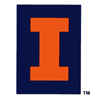|
|
HOME ~ College Football History |
In
1889, University of Illinois student Scott Williams noticed a bulletin
board card announcing that anyone interested in playing football should
report to campus that afternoon.
That day he arrived to see a group of students chasing and kicking a
ball in a manner that barely resembled the game of football
 that he
played at State Normal University, more than 50 miles west of Champaign. that he
played at State Normal University, more than 50 miles west of Champaign.
After the boys’ workout, Williams assembled the group and gave it
instruction on how the ball should be passed and kicked. He also
explained the scoring system and other points of strategy. The gang
reassembled and played a little while longer with Williams as their
leader.
The following year Williams and some teammates approached the heads of
the athletic department with the hopes that they could represent the UI
in a game of football against Illinois Wesleyan at Bloomington.
Anticipating little enthusiasm, Williams suggested that the team pay its
own expenses, provide uniforms and pay its own train fare. Permission
was granted. The first University of Illinois football team boarded a
train Thursday, Oct. 2, 1890, to compete in the Illinois Oratorical
Association meeting in Bloomington, an athletic competition featuring
contests in track, tennis, baseball and football.
With Williams serving as coach, captain and quarterback, Illinois lost
to Wesleyan, 16-0. Although Illinois lost its first football game, it
did win the championship cup for the weekend’s activities.
Illinois’ second game of the season was against Purdue, a team which had
been under great preparation for the game. The Boilers defeated
Illinois, 62-0, but the young UI 11 had learned a few lessons from the
advanced Purdue team before entering the last game of its first season,
a rematch against Wesleyan.
Illinois hosted its first-ever home game Nov. 26, 1890. The contest was
met with great anticipation in the community. Nearly 300 fans arrived at
the Champaign fair grounds to see W.F. Slater score two touchdowns in a
12-6 Illinois victory, which ended its first season with a 1-2 record.
Scott Williams stepped down as captain and coach after the 1890 season,
but remained on the roster as a player on the 1891 Illinois team,
winners of all six games and champions of the Illinois Intercollegiate
Football League.
Chief Illiniwek
One of the most dramatic and dignified traditions in college athletics
is the performance of Chief Illiniwek at the University of Illinois.
Since 1926, this symbol has stirred pride and respect in audiences at
Memorial Stadium, the Assembly Hall and Huff Hall.
Illiniwek (pronounced “ill-EYE-nih-wek”) was the name of the loose
confederation of Algonquin tribes that once lived in the region. The
French changed the ending to “ois” in naming what became the state of
Illinois. Illiniwek means “they are men” and former Illinois football
coach Robert Zuppke is believed to have suggested calling the UI symbol
Chief Illiniwek.
In 1926, Assistant Band Director Ray Dvorak conceived the idea of
performing an American Indian dance during halftime of the Illinois vs.
Pennsylvania football game in Philadelphia. Lester Leutwiler, a student
interested in Indian lore, was chosen for the role. Leutwiler’s
performance, done in a homemade costume, was received so well that he
was asked to continue his dance through the 1928 season.
Webber Borchers, the second Chief Illiniwek, was the first to appear in
authentic American Indian regalia. He initiated a campaign to raise
money to replace his homemade outfit with an authentic one, but with the
Depression on, he received just $15 dollars. However, a Champaign
merchant stepped in to fund the rest and Borchers was off.
He recalled: “In the summer of 1930, I went, at my own expense, to the
Pine Ridge reservation in South Dakota. I hitchhiked out, called an
Indian agent and explained my mission. He and an Indian trader called in
an older Sioux woman. She and two younger women made the suit.”
On Nov. 8, 1930, in New York’s Yankee Stadium, Illinois faced Army in
the seventh game of the season. It was there that Borchers made the
first appearance of Chief Illiniwek in that outfit. Since then, five
different authentic outfits have been used by Chief Illiniwek. The one
used in performances now was purchased in 1983 from Sioux Chief Frank
Fools Crow, and is topped by a headdress of turkey feathers.
Marching Illini
In the 1920s, John Philip Sousa called the Illinois band the “world’s
greatest college band.” Superlatives like this have come to be expected
during the long and illustrious history of the University of Illinois
bands.
Shortly after the University opened in 1868, a military band was
organized. The military band became the Concert Band, and gave its first
formal concert in 1890. The University of Illinois Bands of today are
the top of a pyramid of university band organizations, both concert and
marching, which regularly enroll more than 700 students.
This year’s Marching Illini numbers nearly 360 participants, which
includes musicians, flag corps, Illinettes (a precision dance corps),
drum majors, feature twirlers and staff members.
The unique style of the Marching Illini has become famous, representing
a combination of past traditions and exciting innovations. The Marching
Illini is at the forefront of great university bands, having received
the Louis Sudler Intercollegiate Marching Band Trophy in recognition of
outstanding achievement in 1983. The Marching Illini also have performed
at the Rose, All American, Peach, Liberty, Citrus, Hall of Fame, John
Hancock and Holiday Bowl games.
The Marching Band will perform pregame and halftime shows at all six
home football games this year, as well as selected road games.
Home Page 
|

 that he
played at State Normal University, more than 50 miles west of Champaign.
that he
played at State Normal University, more than 50 miles west of Champaign.